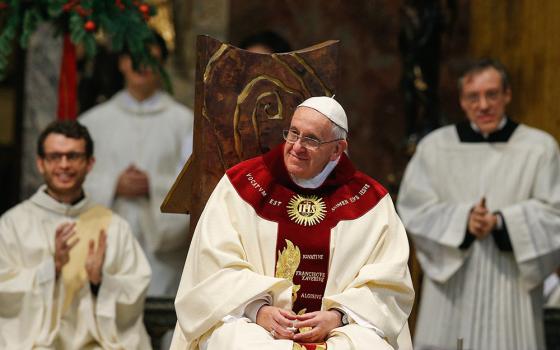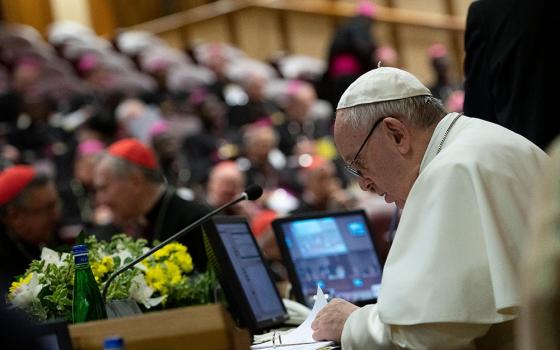2014 was quite a year for those of us who write about the Catholic Church. Looking back at the most important stories of the year, many of them are tied in with Pope Francis but in this column, I will confine my retrospective to events in the United States. So, here are the top stories of the year, ranked in no particular order.
1) Reactions to Pope Francis continued to fascinate. The pope continued to demonstrate wide appeal to almost all Catholics in the U.S. Whatever their ideological and political particularities, people respond to this man in large part because he is so recognizably human, and not afraid to be seen as such.
What I termed last year “Pope Francis Derangement Syndrome” largely abated. Yes, John Zmirak denied there is any such thing as a papal magisterium, and some well-heeled Catholics tried to reduce the pope’s clarion calls for social justice to an appeal for personal charity. A few continued to question the legitimacy of his election. But, by and large, the derangement stopped. Sadly, some commentators and some clerics continue to try and parse the pope’s words, emptying them of their obvious meaning and replacing them with their own perspectives. Indeed, I think one of the things that will warrant further attention in the year ahead is the plain spoken way this pope communicates. In an age riddled with jargon and faux-expertise, when elites in politics and the academy are so far removed from the daily concerns of most people they talk like aliens or with a politically correct vacuity, the pope’s ability to speak from his heart in language all can understand may be one of the most counter-cultural things about him.
Which leads to another aspect of the reaction to him: The divide within the left between those most concerned about sexual issues and those most concerned about social justice issues continued to grow. Many in the first camp object to the way the pope speaks about women. I prefer his homey metaphors, even when they sound like clunkers, to any PC-approved speech. He speaks like a 78-year old Argentine because he is a 78-year old Argentine. And, the focus on his metaphors involving gender roles can too easily keep us from listening to what he is trying to say. This is related to a consistent criticism I have of the Catholic Left: They approach the teachings of the Church they dislike only with a desire to change them, rarely with the disposition to discover what God, through the Church, may be trying to tell us. All of us have experienced difficult moments or tasks from which we grew in ways we never would have otherwise, yet this knowledge is quickly forgotten by ideologues of all stripes who approach Church teachings the way a child approaches play-do. I think the left, not just the right, has to do a better job listening to what t he Holy Father has to say about humility.
2) The appointment of +Blase Cupich as the ninth Archbishop of Chicago is an enormous event in the life of the Church in this country. Here is a born leader, unafraid to be bold or to swim against the current, a brilliant mind and a thoroughly competent administrator, elevated to one of the most important dioceses in the country. Ad extra, +Cupich was one of the few bishops to have diocesan and Catholic Charities staff trained as navigators for the Affordable Care Act. Ad intra, he had one of the most robust consultations on family issues in advance of the synod. He is a dynamo. As well, if in New York, the rise of financial titans and media stars has taken some, actually a lot, of the Church’s cultural juice once embodied in the person of the Cardinal-Archbishop of that city, in Chicago, it is still the mayor and the archbishop who dominate the socio-cultural landscape. And, if the local Chicago media is any guide, +Cupich has taken the city by storm.
The appointment is significant in its own right. If the pope had called me and asked who should go to Chicago, I would have put +Cupich’s name at the top of my terna. Of course, the pope did not call me, but he did consult widely and whomever he consulted came up with +Cupich’s name. The pope surely knew this would probably be the most important appointment he makes in the U.S. Church and he found the right guy. I suspect it also shows the influence of Washington’s Cardinal Donald Wuerl and Boston’s Cardinal Sean O’Malley, both of whom have been out front of the rest of the brethren in their enthusiasm for Pope Francis and whose advice to the pope was likely taken. The fact that the pope got this right bodes well for other matters, for example, the planning of his trip to the U.S. next September. He will not let his appearances be turned into an opportunity to blast the Obama administration, which is certainly what some would have liked.
+Cupich has extensive experience in the USCCB, holding a variety of positions on different committees over the years. At times in its history, the leadership of the USCCB came almost entirely from the great Midwestern dioceses: Cincinnati, Cleveland, Detroit, Chicago, St. Louis and St. Paul. They were often a bulwark of collegiality against the more authoritarian cardinalatial sees in the Northeast. Look for +Cupich to reinvigorate the USCCB and help pull it back from the culture war limb it has climbed out on.
3) At the end of last year, Pope Francis removed Cardinals Raymond Burke and Justin Rigali from the Congregation of Bishops, and replaced them with Cardinal Wuerl. For a variety of reasons, most of the attention focused on the removal of Cardinal Burke, but the end of the +Rigali-era may be the most important development in the U.S. Church.
The two cardinals, especially +Rigali, embody the clerical mindset that has crippled the Church, turned it into what Pope Francis calls a “self-referential” Church, tone deaf at times, unwelcoming, joyless. And, together, these former archbishops of St. Louis have spread their influence far and wide throughout the U.S. Church. Bishop Robert Finn, who should have resigned long ago, is a creation of the two. Archbishop Salvatore Cordileone was a student of +Burke’s and a close friend. +Rigali promoted both +Fabian Bruskewitz, who thumbed his nose at the Dallas Charter for a decade, and Bishop Thomas Olmsted, who announced the removal of the designation “Catholic” from a local hospital in a statement that did not once mention the Lord Jesus nor quote from the Scriptures, although the references to canon law and the USCCB ethical directives were aplenty. Bishop David Malloy was ushered into the Vatican diplomatic corps by +Rigali, as was Cardinal James Harvey. Archbishop John Nienstedt worked with +Rigali in Rome, and Bishop Robert Vasa, who also refused to comply with the Dallas Charter, and Archbishop Leonard Blair, who led the initial investigation of the LCWR, both have Cardinal Burke as their patrons. Some of the men on this list are talented. All, I am sure, are prayerful. But, all of them, along with others, have been complicit in the marginalization of the Church in our culture by adopting a defensive posture and a culture warrior approach that is the antithesis of Pope Francis’ approach.
4) The rise of immigration as an issue that unites the Church was the most obvious policy-oriented development in 2014. Following the example of Pope Francis’ visit to Lampedusa, the USCCB Committee on Migration held their spring meeting not in Washington, D.C. but in Tucson, Arizona and they started with a Mass at the border led by Cardinal Sean O’Malley. The event garnered extensive and positive media coverage of the kind U.S. bishops have not gotten since before the clergy sex abuse crisis. The searing images of Cardinal Sean and Bishop Gerald Kicanas serving Holy Communion through the slats in the border fence went viral. Then, this summer, when there was a significant uptick in the number of unaccompanied minors coming across the border, the bishops responded with compassion and effectiveness. The compassion contrasted decisively with the angry protesters urging deportation. The effectiveness – the Church was able to help re-locate thousands of children away from detention centers and into homes – made the point yet again that the opposite of the much-derided “organized religion” is “disorganized religion.”
The issue of immigration has many aspects. Obviously, the most vital is immediate assistance to those who risk life and limb to come to our country. To me, among the most important is that our Church’s stance on this issue helps us be true to our own history as a Church of immigrants and, in turn, helps our nation be true to its own history as well. When the prophets of Israel called their people to repentance, as Cardinal George once pointed out, they did not instruct the people to cease to be Israelites.
5) Concern of the plight of immigrants, and a willingness to elevate this issue to top-tier status among the concerns of the bishops’ conference, is not a done deal which highlights the fifth big story of 2014: The reluctance of the fifth floor at the USCCB headquarters (where leadership has their offices) to get with the Pope Francis program. The leadership of the USCCB rushed out a couple of strong statements opposing President Obama’s LGBT non-discrimination order, but the letter sent to President Obama supporting executive action on immigration had no press release, no placement on the USCCB website, and no one even knew it existed until our colleague Grant Gallicho unearthed it a couple of months later. Then, at the November meeting of the USCCB, Archbishop Kurtz’s maiden presidential address did not mention the issue, although a mention of the “Theology of the Body” found its way into the text.
For the past couple of decades, conservative voices have raised the concern that the USCCB was too staff-driven and that the bishops needed to regain control over the organization. It turns out, those voices are perfectly content to have a staff-driven organization, provided the staff are all conservative Republicans. To be sure, as a whole, the body of bishops leans hard to the right, so in a sense, the staff has been taking its cue from them. But, the fifth floor remains what one friend calls “a Francis-free zone.” They have scheduled another “Fortnight for Freedom,” an event that does not exist in most dioceses and which has become something of a laughing stock in the others. They were completely ineffective in getting the House Republicans to vote on immigration reform in the lame duck session. I confess I shudder to think that an organization that is so ideologically driven and so enclosed in its own little world will have any role in planning the Holy Father’s trip to the U.S. next year.
6) The release of the report on the visitation of women’s religious orders was a fascinating example of how vitriol and suspicion and deteriorating relationships can make a big brouhaha over something that should be a normal part of ecclesial life. The initial visitation was announced without prior consultation and received as an insult. All praise under heaven goes to Mother Clare Millea who led the visitation in such a way that the fears of most were calmed and the process became fruitful, even in the eyes of many of those who initially criticized it.
I have also heard very good reports about Archbishop Peter Sartain’s undertaking of his thankless task of leading the unrelated but parallel visitation of the LCWR. I agree with Cardinal O’Malley that the whole thing has been a disaster but I also hope that everyone involved will learn from that disaster. The Vatican never should have gotten itself involved in this. I can’t print in a family newspaper my thoughts about those who instigated this whole fiasco. But, I also hope the LCWR will recognize that, for all the poorly handled way of raising some issues, some issues need to be raised. And, anyone who looks at +Sartain and sees a troglodyte or a misogynist is projecting their own fears onto a man who deserves better.
7) I admit that this last story of the year is one very close to my heart, and my thoughts on it might be a bit biased. Nonetheless, I think the claim can be made that the emergence of anti-libertarianism as a central organizing principle for the Catholic Left is one of the most important developments in 2014 and beyond. All the cultural, and much of the political, zeitgeist has swallowed more libertarianism than it cares to admit. It terrifies me. I am especially terrified to see this heresy making inroads into the life of the Church via groups like the Acton Institute and the Napa Institute. I had hoped the bishops would stiffen their spines and defend Catholic Social Doctrine, but we are still waiting.
The libertarian impulse runs through our culture like a faultline. It touches everything and corrupts everything it touches. It not only contradicts Catholic teaching it is a heresy of liberalism too, taking an appropriate concern for human freedom and running amok with it. Sometimes the Republicans champion it, at least when we are discussing wallets, and sometimes the Democrats champion it, at least when we are discussing sexual mores and pot legalization. It is dangerous and deadly and I do not see its appeal diminishing anytime soon because so few on the left and the right who are suspicious of libertarianism have perfected a language that can contradict it and defeat it. There is no more pressing need for the Church in the United States than to gird itself to resist libertarianism. In 2014, that discussion began in earnest with a conference sponsored by Catholic University’s Institute for Policy Research & Catholic Studies, and we were shocked, happily, to realize that serious Catholics were just dying to have this discussion. Some of my most liberal friends and some of my most conservative friends, all were so excited, it was like watching people go to their first major league baseball game.
So, that is my top 7 list. I suppose I could add three more and make it a top ten list, but these seem to me to be the biggest stories in the stateside Church in 2014. Tomorrow, I will look at what I expect will be the biggest stories in 2015.




